Foreign Exchange
A growing number of central banks are diversifying their foreign currency reserves away from the dollar and into the British pound, the euro and the yen.
While its an old story, the issue is still a sensitive one for backers of the dollar. When Federal Reserve Bank of San Francisco president Janet Yellen said in response to a question in early November that some countries may diversify reserves away from the greenback, her comment triggered a brief decline in the dollar.
Alexei Ulyukayev, first deputy chairman of the Russian central bank, said he could increase the banks yen holdings from almost nothing at present. Russias reserves are the third largest in the world and have risen about 50% since January to $268 billion due to the countrys surging oil revenue. China and Japan, the worlds largest holders of currency reserves, could diversify their huge dollar holdings in the future, analysts say. Chinas reserves recently passed $1 trillion.
Former Fed chairman Alan Greenspan said in a speech in late October that the dollar was being challenged as the worlds reserve currency. Were beginning to see some move from the dollar to the euro, both from the private sector and also from monetary authorities and central banks, he said.
The dollar diversification story is returning to haunt the US currency, as the United Arab Emirates central bank reasserts its plans to increase its holdings in euro reserves by 10%, as well as raise its share in the British pound and the yen, says Ashraf Laidi, chief foreign exchange analyst at CMC Markets in New York. Although the UAE central bank made similar comments earlier this year, the latest remarks stand out, since they specify that dollar reserves could be reduced to as low as 50% of the total of $25 billion currently held, he says. The central bank noted that its reserves were 98% in dollars and 2% in euros.
The importance of these comments, according to Laidi, was underlined by the fact that they came two days after Switzerlands central bank revealed that it had added yen to its $36 billion in foreign currency reserves and trimmed the share of dollars, while raising its allocation to other currencies. The Swiss National Bank boosted its yen holdings to 4.9% of its reserves from 3% in the previous quarter.
With the Federal Reserve expected to have concluded its interest rate hike campaign and US growth slowing to its lowest levels in three years, world central banks are fulfilling their profit-maximizing functions, Laidi says. They are attempting to sell a portion of their dollar reserves at a relatively high level in the dollar, while adding to their reserve holdings of assets they expect to gain in the medium to long term, such as the yen, the euro, the UK pound and gold, he says.
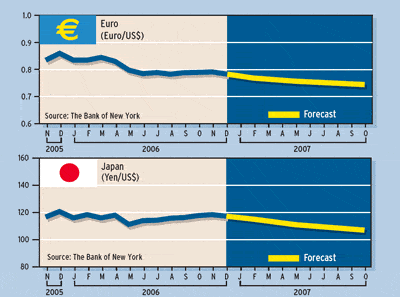
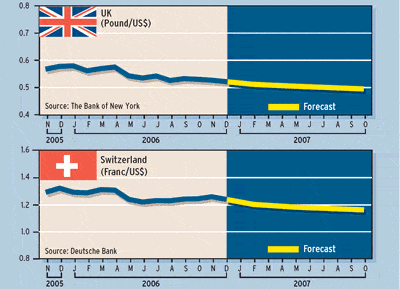
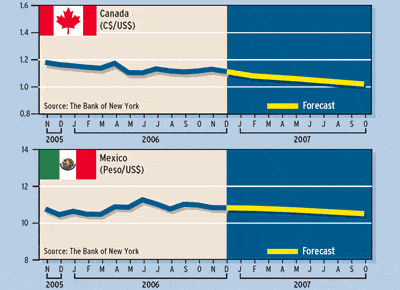
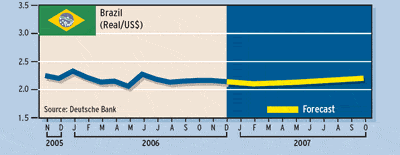
Meanwhile, the combination of expected monetary policy tightening in Japan and Switzerland and slowing growth in the United States presents considerable risk of capital loss to market participants in the yen and Swiss franc carry trades, Laidi says. Those implementing strategies of borrowing in low-interest-rate currencies to invest in higher-yielding currencies could be in for a rude awakening, he notes. This is especially so in light of concerns expressed by the Bank of Japan about excessive yen carry trades, as well as improvement in Swiss economic fundamentals, he says.
Despite signs of broad economic weakness in the US, there is still reason to believe that there will be a soft landing, characterized by a slowdown in growth without protracted losses in payrolls or widespread declines in home values curtailing personal consumption, Laidi says.
Both US personal income and spending remained solid for the first three quarters of this year, despite the continued slowdown in the housing market, says Michael Woolfolk, senior currency strategist at The Bank of New York.
The dollars positive reaction to the personal income and spending report for September reflected a sense that this report was the latest confirmation of a soft-landing scenario for the US economy in 2007, Woolfolk says. Full-employment conditions and strong personal-income growth have made the US consumer highly resilient to shocks that would have ordinarily derailed spending, he says. While there is no doubt that the housing market is cooling as widely feared, the drop in energy prices and recent record highs in the Dow [Jones industrial average] are bolstering confidence and supporting spending ahead of the holiday shopping season, according to Woolfolk.
And while a rate hike by the Fed appears to be off the table following the latest round of economic growth and inflation data, Woolfolk says, calls for a Fed rate cut early next year appear equally premature. The US employment report for October made it abundantly clear that there is no shortage of jobs in the US just now, he says. Payroll growth in October was 92,000, while September and August payrolls were revised upward by a combined 139,000. Benchmark revisions will be adding more than 830,000 jobs to the period from April 2005 through March 2006. The US unemployment rate in October fell to 4.4%, the lowest since May 2001.
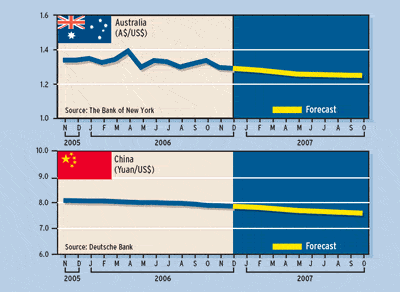
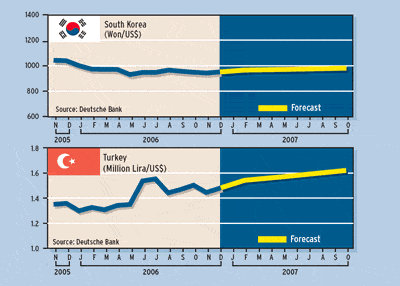
Despite worries about financing the record US current-account deficit, Woolfolk says he expects the dollar to remain supported in the months ahead by reserve flows from Asian central banks and oil-exporting countries. With $3.7 trillion of global custody business and $13 trillion of assets under administration, The Bank of New York has a proprietary view of crossborder capital flows. The bank recently launched the second generation of its Interactive Portfolio Flow Monitor, or iPFM, which provides charts of non-domestic investment flows into and out of 38 major asset markets. It can be used to analyze bilateral flows on a daily basis over the past five years. The charts can be overlayed with graphs of a wide range of currencies or equity or fixed-income indexes. A flow matrix provides an overview of crossborder flows across all markets covered.
The Bank of New Yorks crossborder capital flow data are updated daily with an overnight feed from its custody division. The US Treasurys monthly report on capital flows into and out of the US, known as the Treasury International Capital System, or TICS data, is released with a delay of six weeks.
Gordon Platt



